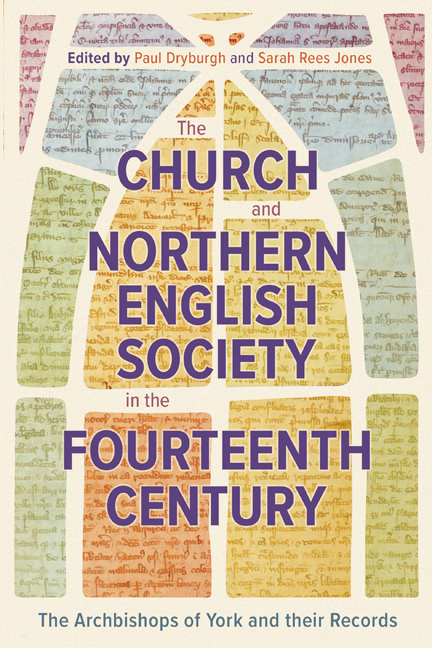 The Church and Northern English Society in the Fourteenth Century
The Church and Northern English Society in the Fourteenth Century Book contents
- Frontmatter
- Dedication
- Contents
- List of Illustrations
- List of Contributors
- Acknowledgements
- List of Abbreviations
- Map: The Ecclesiastical Province of York, c. 1304–1405
- Introduction
- 1 The Administrative Records of the Archbishops of York, 1304–1405
- 2 The Archbishops of York and the Government of Fourteenth-Century England
- 3 Support or Scourge? Archbishop William Melton and the Tradition of Loyal Opposition to the English
- 4 Beyond the Border: The Influence of York Clerks in the Two Edwards’ Scottish Administrations, 1332–1357
- 5 Responding to Royal Requirements: Clerical Taxation in the Province of York, 1304–1405
- 6 Ad insolenciam ipsius rebellis salubrius reprimendam: William Thorntoft, the Abbey of Rufford and Significations of Excommunication in the Northern Province
- 7 Blood, Sex and Holy Water: Reconciling Churches and Churchyards in the Medieval Diocese of York
- 8 Structuring Episcopal Authority: Palaces and Residences of the Archbishop of York
- 9 Medieval Parks of the Archbishops of York
- 10 Northern Ways? Pilgrimage, Politics and Piety in the Fourteenth-Century Administrative Records of the Archdiocese of York
- 11 Underexplored Sources for Gender History: New Approaches to the Fourteenth-Century York Archbishops’ Registers
- 12 Joan of Leeds and other Apostate Nuns in the Province of York, 1300–1350
- Bibliography of Records of the Archbishops of York, 1304–1405
- Index
7 - Blood, Sex and Holy Water: Reconciling Churches and Churchyards in the Medieval Diocese of York
Published online by Cambridge University Press: 17 May 2024
- Frontmatter
- Dedication
- Contents
- List of Illustrations
- List of Contributors
- Acknowledgements
- List of Abbreviations
- Map: The Ecclesiastical Province of York, c. 1304–1405
- Introduction
- 1 The Administrative Records of the Archbishops of York, 1304–1405
- 2 The Archbishops of York and the Government of Fourteenth-Century England
- 3 Support or Scourge? Archbishop William Melton and the Tradition of Loyal Opposition to the English
- 4 Beyond the Border: The Influence of York Clerks in the Two Edwards’ Scottish Administrations, 1332–1357
- 5 Responding to Royal Requirements: Clerical Taxation in the Province of York, 1304–1405
- 6 Ad insolenciam ipsius rebellis salubrius reprimendam: William Thorntoft, the Abbey of Rufford and Significations of Excommunication in the Northern Province
- 7 Blood, Sex and Holy Water: Reconciling Churches and Churchyards in the Medieval Diocese of York
- 8 Structuring Episcopal Authority: Palaces and Residences of the Archbishop of York
- 9 Medieval Parks of the Archbishops of York
- 10 Northern Ways? Pilgrimage, Politics and Piety in the Fourteenth-Century Administrative Records of the Archdiocese of York
- 11 Underexplored Sources for Gender History: New Approaches to the Fourteenth-Century York Archbishops’ Registers
- 12 Joan of Leeds and other Apostate Nuns in the Province of York, 1300–1350
- Bibliography of Records of the Archbishops of York, 1304–1405
- Index
Summary
One Monday at the very end of the fourteenth century, John Green, the perpetual vicar of the prebendal church of Wistow, and John Keleby, the chaplain and parish clerk of the same church, were saying the verses of the day. Then Green stumbled over his words, Keleby laughed, and Green threw his psalter at the clerk. This unseemly incident may well have gone unrecorded, except for the fact that the book ‘slightly broke the skin of his [Keleby’s] head, so that a little blood appeared on the surface, but slight in quantity’. Consequently, the two men went together to Cawood to tell the archbishop of York what had happened. Archbishop Richard Scrope determined that the church had been polluted by the violence committed therein; it must therefore be reconciled.
The idea that a church could be contaminated by bodily fluids was an old one, with its roots in Levitical prohibitions; the idea that a polluted church should be ritually reconciled probably derived from the same source, specifically the ritual for purifying a leper's house. During the course of the Middle Ages, such ideas became firmly entrenched in canon law: the early eleventh century Excerptiones Ecberti Eborcensi archiepiscopi (which were probably written by Wulfstan of York) specify that reconsecration was necessary if a church was polluted by murder or adultery, and the idea that emissions of blood and semen (along with fire and the burial of an infidel or excommunicate) could contaminate a church or churchyard was restated by all the major canonists, including Gratian.
By the later Middle Ages, the main concerns seem to have been bloodshed and sex, both of which could be deeply problematic, and not just because of cultural taboos about bodily fluids. Once a church had been consecrated (that is, as William Durandus put it, once it had been ‘dedicated in a ceremony by the hands of a bishop, and sanctified by God’), it became a sacred space, suitable for activities such as praising God and administering the sacraments. Moreover, as Daniel Thiery has argued, only God was entitled to enact violence in such a place; consequently, prohibitions on violence formed an important part of the consecration ceremony, and acts that would be licit in the secular world were sinful here.
- Type
- Chapter
- Information
- The Church and Northern English Society in the Fourteenth CenturyThe Archbishops of York and their Records, pp. 191 - 207Publisher: Boydell & BrewerPrint publication year: 2024


